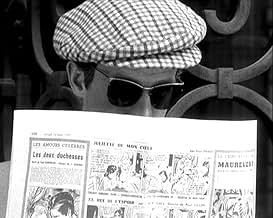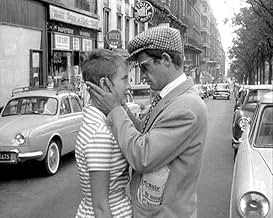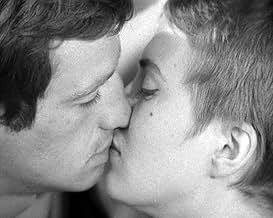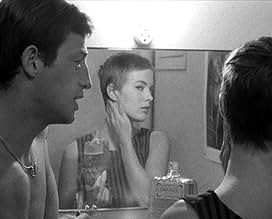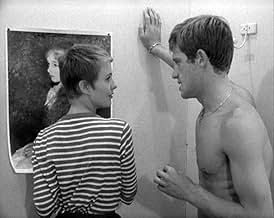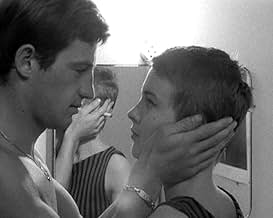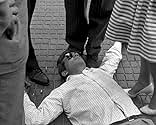AVALIAÇÃO DA IMDb
7,7/10
92 mil
SUA AVALIAÇÃO
Um pequeno ladrão rouba um carro e mata impulsivamente um policial. Procurado pelas autoridades, ele conhece um estudante de jornalismo e tenta convencê-la a fugir com ele para a Itália.Um pequeno ladrão rouba um carro e mata impulsivamente um policial. Procurado pelas autoridades, ele conhece um estudante de jornalismo e tenta convencê-la a fugir com ele para a Itália.Um pequeno ladrão rouba um carro e mata impulsivamente um policial. Procurado pelas autoridades, ele conhece um estudante de jornalismo e tenta convencê-la a fugir com ele para a Itália.
- Direção
- Roteiristas
- Artistas
- Indicado para 1 prêmio BAFTA
- 5 vitórias e 4 indicações no total
Jean-Paul Belmondo
- Michel Poiccard a.k.a. Laszlo Kovacs
- (não creditado)
Jean Seberg
- Patricia Franchini
- (não creditado)
Richard Balducci
- Tolmatchoff
- (não creditado)
Daniel Boulanger
- Police Inspector Vital
- (não creditado)
Gérard Brach
- Photographer
- (não creditado)
Philippe de Broca
- A Journalist
- (não creditado)
José Bénazéraf
- Man in a White Car
- (não creditado)
Jean Domarchi
- A Drunk
- (não creditado)
Jean Douchet
- A Journalist
- (não creditado)
Liliane Dreyfus
- Liliane
- (não creditado)
- …
Michel Fabre
- Police Inspector #2
- (não creditado)
Jean-Luc Godard
- The Snitch
- (não creditado)
Roger Hanin
- Carl Zubart
- (não creditado)
Henri-Jacques Huet
- Antonio Berrutti
- (não creditado)
Raymond Huntley
- A Journalist
- (não creditado)
André S. Labarthe
- Journalist at Orly
- (não creditado)
- Direção
- Roteiristas
- Elenco e equipe completos
- Produção, bilheteria e muito mais no IMDbPro
Avaliações em destaque
The film that both kicked off the French New Wave era and best represents it, "Breathless", is very entertaining. Perhaps there is some deep commentary on the human condition that I am completely missing, but as far as I can tell, this is an example of a film that is more concerned with style over substance.
The most important thing this film is remembered for is it's general disregard for the so called "rules" of filmmaking. It boasts groundbreaking cinematography, introducing the "Jump Cut" to make the film's pacing more kinetic. The other most notable aspect of this film is its dialogue: natural, yet almost poetic in its delivery.
The two leads are very charming, especially Belmondo's Michel. His suave demeanor and charismatic presence steals whatever scene he's in. Jean Seberg's turn as Patricia is more subtle and nuanced, making her role the more complex of the two, even if it's not as entertaining as Belmondo's performance.
As I have stated earlier, this is not a film that is concerned with plot as much as it is feel. Director Jean-Luc Goddard was trying to do something new for the cinema world, and succeeded in doing so. "Breathless" is a must see for any cinephile due to its long term impact on film as a medium.
8.5/10.
The most important thing this film is remembered for is it's general disregard for the so called "rules" of filmmaking. It boasts groundbreaking cinematography, introducing the "Jump Cut" to make the film's pacing more kinetic. The other most notable aspect of this film is its dialogue: natural, yet almost poetic in its delivery.
The two leads are very charming, especially Belmondo's Michel. His suave demeanor and charismatic presence steals whatever scene he's in. Jean Seberg's turn as Patricia is more subtle and nuanced, making her role the more complex of the two, even if it's not as entertaining as Belmondo's performance.
As I have stated earlier, this is not a film that is concerned with plot as much as it is feel. Director Jean-Luc Goddard was trying to do something new for the cinema world, and succeeded in doing so. "Breathless" is a must see for any cinephile due to its long term impact on film as a medium.
8.5/10.
Watching Jean-Luc Godard's massively influential, unintentional-classic Breathless and discussing Jean-Luc Godard's massively influential, unintentional-classic Breathless are two totally different things. For one, the latter is more fun the other and, two, discussing the film almost instantly allows for quality, intelligent discussion of cinema to ring. There are certain cinephiles that take Godard himself more seriously than they take any other director who has ever lived. Just when you thought Stanley Kubrick-fanatical elitism was out of control, spend about ten minutes, as an exercise, scouring the internet for French New Wave forums and in-depth analysis of the Godardian methods and you may be surprised at what you find.
I'm only stating this because around a year and a half ago, I began my sporadic voyage into the depths of Godard with his most recent picture, at the time, Film Socialisme, which I found to be an assault on every conceivable sense and not in a particularly good way. The film was choppy, disjointed, messy, just about as incomprehensible as it could be, and trying to find justifications or analyses online proved ineffective. All and all, it's a film I just want to forget and I didn't care to dive into Godard much after that endeavor. I now realize that a decent part of the blame is on me for choosing perhaps the wrong film to begin my Godardian journey with. I emerge from seeing Breathless (known by its French title as À bout de soufflé) with a more of a positive reaction. This is a bravely-structured and maturely handled annihilation to every cinematic convention prior to its 1960 release down with class and impenetrable style on part of Godard.
The story - even though it is relatively the least of our concerns - follows Michel (Jean-Paul Belmondo), who is trying to emulate the characteristics possessed by Humphrey Bogart during the particular 40s/50s era of menacing American crime dramas that billed him as the lead actor. One day, feeling intimidated and a perhaps a little adventurous, Michel shoots a police officer who has been tailing him and now must deal with being broke and on the run from the cops. His only companion is Patricia (Jean Seberg), an American journalist getting by in life by selling newspapers in downtown Paris. The two desperately skim through their options trying to hide from the police, one of which is skipping town and going all the way to Italy as fugitives.
I say the story is the least of our concerns because there is simply not much to it. After all, Breathless is an aesthetic breakthrough rather than a narrative one. Godard employs dangerously subversive jump cuts - where the camera cuts to another shot within the same frame creating a breach in continuity - along with rapid-fire, quick shots and lengthy dialog scenes. All of this broke French cinema convention, which, prior to this, was consistently polished and very elegant. Godard invited in a rebellious messiness to the picture, almost like the guy coming into a neatly-organized room and rustling all the papers and files to not only create a stir but to do something different, something completely new.
It's almost shortchanging to simply say that I have immense respect for Godard seeing as in 1960, a time when social change and civil unrest amongst adolescents and twentysomethings seemed to be so prevalent in many different places, he ushered in a new way of doing things cinematically and created a stylistically bold film because of it. He even threw in the element of using a hand-held camera, an unheard of practice during this particular time. I think I would also be in line to compare Breathless to Bonnie and Clyde, a film that would enter the picture seven years later in American studios that would simultaneous shock and stimulate audiences everywhere.
Godard's films have a unique power after you watch them. For example, it has been about four days since I sat down to watch Breathless and since watching it - and now writing a medium-length analysis of it - I have a strong, biting urge to watch more of Godard's films. His films have the kind of impact where you just want to talk about them and talk about their impact in great length; which, once more, brings me to the point that watching the films is actually the weaker part compared to discussing them.
Starring: Jean-Paul Belmondo and Jean Seberg. Directed by: Jean-Luc Godard.
I'm only stating this because around a year and a half ago, I began my sporadic voyage into the depths of Godard with his most recent picture, at the time, Film Socialisme, which I found to be an assault on every conceivable sense and not in a particularly good way. The film was choppy, disjointed, messy, just about as incomprehensible as it could be, and trying to find justifications or analyses online proved ineffective. All and all, it's a film I just want to forget and I didn't care to dive into Godard much after that endeavor. I now realize that a decent part of the blame is on me for choosing perhaps the wrong film to begin my Godardian journey with. I emerge from seeing Breathless (known by its French title as À bout de soufflé) with a more of a positive reaction. This is a bravely-structured and maturely handled annihilation to every cinematic convention prior to its 1960 release down with class and impenetrable style on part of Godard.
The story - even though it is relatively the least of our concerns - follows Michel (Jean-Paul Belmondo), who is trying to emulate the characteristics possessed by Humphrey Bogart during the particular 40s/50s era of menacing American crime dramas that billed him as the lead actor. One day, feeling intimidated and a perhaps a little adventurous, Michel shoots a police officer who has been tailing him and now must deal with being broke and on the run from the cops. His only companion is Patricia (Jean Seberg), an American journalist getting by in life by selling newspapers in downtown Paris. The two desperately skim through their options trying to hide from the police, one of which is skipping town and going all the way to Italy as fugitives.
I say the story is the least of our concerns because there is simply not much to it. After all, Breathless is an aesthetic breakthrough rather than a narrative one. Godard employs dangerously subversive jump cuts - where the camera cuts to another shot within the same frame creating a breach in continuity - along with rapid-fire, quick shots and lengthy dialog scenes. All of this broke French cinema convention, which, prior to this, was consistently polished and very elegant. Godard invited in a rebellious messiness to the picture, almost like the guy coming into a neatly-organized room and rustling all the papers and files to not only create a stir but to do something different, something completely new.
It's almost shortchanging to simply say that I have immense respect for Godard seeing as in 1960, a time when social change and civil unrest amongst adolescents and twentysomethings seemed to be so prevalent in many different places, he ushered in a new way of doing things cinematically and created a stylistically bold film because of it. He even threw in the element of using a hand-held camera, an unheard of practice during this particular time. I think I would also be in line to compare Breathless to Bonnie and Clyde, a film that would enter the picture seven years later in American studios that would simultaneous shock and stimulate audiences everywhere.
Godard's films have a unique power after you watch them. For example, it has been about four days since I sat down to watch Breathless and since watching it - and now writing a medium-length analysis of it - I have a strong, biting urge to watch more of Godard's films. His films have the kind of impact where you just want to talk about them and talk about their impact in great length; which, once more, brings me to the point that watching the films is actually the weaker part compared to discussing them.
Starring: Jean-Paul Belmondo and Jean Seberg. Directed by: Jean-Luc Godard.
Together with François Truffaut's "The 400 Blows" (one of my favorites), Jean-Luc Godard's "Breathless" is considered the defining, instigating film of the French New Wave. It's more ironic and detached, less emotionally accessible than "The 400 Blows," and its technical innovations like jump cuts are perhaps even more surprising. For these reasons, I found "Breathless" easier to admire than to lovethough by the end I grew to enjoy its too-cool- for-(film)-school tone.
Ironically, the pace of this movie isn't "breathless" at all. It begins abruptly and takes a while to get going: Michel (Jean-Paul Belmondo), a character we barely know, drives a stolen car around, talks at the camera, and shoots a police officer who has tried to pull him over. Then he goes to Paris and tries to borrow money from some friends, while the police-shooting plot goes undeveloped. I only became fully engaged with the introduction of Patricia (Jean Seberg), a young American who sells newspapers on the Champs-Elysees. The relationship between Michel and Patricia is the heart of the film, especially a 25-minute-long scene in Patricia's apartment where the characters smoke, flirt, and laze around in bed, though nothing really happens. That's where I really started to admire "Breathless," because I was so captivated by a scene that, on paper, doesn't sound all that captivating.
Eventually the police catch onto Michel and launch a manhunt, but this doesn't really ratchet up the suspense. Instead, Michel is (or at least, Michel acts) aimless and nonchalant about the whole thingthis is not a typical "man on the run" movie. The cool jazz score adds to the hip, laid-back tone.
Since I didn't care for the movie too much until the scenes between Michel and Patricia, I believe a lot of the credit for the film's success has to go to the charismatic performances of Belmondo and Seberg. Belmondo, with a perpetual cigarette dangling from the corner of his mouth, is the archetypal cocky criminal who models himself after Humphrey Bogart (there's a great scene where he sees some Bogart photos and gets a vulnerable look in his eyes, as though saying "I'll never be as cool as this"). Seberg plays Patricia as a confused girl who is delighted by the attention she gets as an American in France.
It's easy to see why "Breathless" was so influentialthe jump cuts, the ragged style perfectly match this story about amoral, aimless youth. Definitely a movie that expanded the range of stories the cinema can tell, and perhaps a major precursor to youth-oriented '60s culture. Nearly fifty years later, it still seems "hip," and still challenges our expectations of how movies should behave.
Ironically, the pace of this movie isn't "breathless" at all. It begins abruptly and takes a while to get going: Michel (Jean-Paul Belmondo), a character we barely know, drives a stolen car around, talks at the camera, and shoots a police officer who has tried to pull him over. Then he goes to Paris and tries to borrow money from some friends, while the police-shooting plot goes undeveloped. I only became fully engaged with the introduction of Patricia (Jean Seberg), a young American who sells newspapers on the Champs-Elysees. The relationship between Michel and Patricia is the heart of the film, especially a 25-minute-long scene in Patricia's apartment where the characters smoke, flirt, and laze around in bed, though nothing really happens. That's where I really started to admire "Breathless," because I was so captivated by a scene that, on paper, doesn't sound all that captivating.
Eventually the police catch onto Michel and launch a manhunt, but this doesn't really ratchet up the suspense. Instead, Michel is (or at least, Michel acts) aimless and nonchalant about the whole thingthis is not a typical "man on the run" movie. The cool jazz score adds to the hip, laid-back tone.
Since I didn't care for the movie too much until the scenes between Michel and Patricia, I believe a lot of the credit for the film's success has to go to the charismatic performances of Belmondo and Seberg. Belmondo, with a perpetual cigarette dangling from the corner of his mouth, is the archetypal cocky criminal who models himself after Humphrey Bogart (there's a great scene where he sees some Bogart photos and gets a vulnerable look in his eyes, as though saying "I'll never be as cool as this"). Seberg plays Patricia as a confused girl who is delighted by the attention she gets as an American in France.
It's easy to see why "Breathless" was so influentialthe jump cuts, the ragged style perfectly match this story about amoral, aimless youth. Definitely a movie that expanded the range of stories the cinema can tell, and perhaps a major precursor to youth-oriented '60s culture. Nearly fifty years later, it still seems "hip," and still challenges our expectations of how movies should behave.
There's a rogue with several pseudonyms in tow, a small time crook who several girls think is a beau, not the most, trustworthy guy, he'll spin a yarn or two and lie, so be careful where you keep your hard earned dough. He's been known to shoot and kill with firearm, after being chased by the local gendarme, so he's off to Italy, when he's collected fiscally, will take Patricia, who's been caged by Gallic charm.
Still a wonderful introduction to the world of French cinema of the time, but needs to be taken in context as familiarity breeds contempt and this was, after all, part of the foundations and a cornerstone of so much of what was to come. Imaginatively and innovatively directed by one of the greatest, with two flowers of the 60s revealing their early petals, and after smoking so many cigarettes, is it any wonder you'd struggle to catch your breath!
Still a wonderful introduction to the world of French cinema of the time, but needs to be taken in context as familiarity breeds contempt and this was, after all, part of the foundations and a cornerstone of so much of what was to come. Imaginatively and innovatively directed by one of the greatest, with two flowers of the 60s revealing their early petals, and after smoking so many cigarettes, is it any wonder you'd struggle to catch your breath!
So says the novelist in response to Patricia's question, "What do you hope to attain out of life?" That response is the philosophy of the film and of every character in the film. All want to be in control of their destiny. All want to be something that they are not. None are able to do any of these things. They are all contradictions. How can you die as an immortal? How can Patricia be free and independent is so many other things determine what she can do? How can this film transcend the screen while existing on the screen? This is an amazing film to watch. Goddard fills every scene with ingenuity and energy. He puts his actors in a beautiful environment and lets them do their thing. And they do it extremely well. The actors are beautiful. Not just cosmetically, but spiritually and psychologically. I am not sure that I liked either of the two main characters. I am sure I could not keep my eyes off them. I could not take my eyes off the screen. Techniques that novices today use for no substantial purpose are utilized by Goddard to amazing effect. The greatest filmmakers are the great editors. Goddard makes the editing a character itself. It is the nervous narrator hurrying the film along. It breathlessly awaits the next scene, and leads us to do the same. I like the way Goddard spends prodigious time simply watching his characters. The conversation scene at the center of the film is amazingly long and drawn out, yet I did not find it boring. I found it fascinating. People are fascinating. Everyone is trying to be something. It takes tremendous talent to indulge in the minutiae of existence. A great film.
Você sabia?
- CuriosidadesDespite reports to the contrary, Jean-Luc Godard did not shoot the film without a script; however, he did not have a finished script at the beginning, instead writing scenes in the morning and filming them that day. See also O Demônio das Onze Horas (1965).
- Erros de gravaçãoDuring street shots, countless passersby look at Patricia and Michel and stare into the camera, revealing that the shots were made without filming barriers and simply used street pedestrians in place of extras.
- Citações
Patricia Franchini: What is your greatest ambition in life?
Parvulesco: To become immortal... and then die.
- ConexõesEdited into Pariz pripada nama! (2016)
Principais escolhas
Faça login para avaliar e ver a lista de recomendações personalizadas
Detalhes
- Data de lançamento
- País de origem
- Idiomas
- Também conhecido como
- Sin aliento
- Locações de filme
- 11 rue Campagne Première, Paris 14, Paris, França(on location)
- Empresas de produção
- Consulte mais créditos da empresa na IMDbPro
Bilheteria
- Orçamento
- FRF 400.000 (estimativa)
- Faturamento bruto nos EUA e Canadá
- US$ 414.173
- Fim de semana de estreia nos EUA e Canadá
- US$ 32.424
- 30 de mai. de 2010
- Faturamento bruto mundial
- US$ 594.039
- Tempo de duração1 hora 30 minutos
- Cor
- Mixagem de som
- Proporção
- 1.37 : 1
Contribua para esta página
Sugerir uma alteração ou adicionar conteúdo ausente






